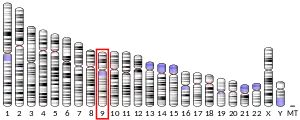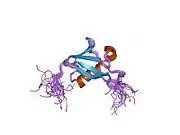| BAG1 | |||||||||||||||||||||||||||||||||||||||||||||||||||
|---|---|---|---|---|---|---|---|---|---|---|---|---|---|---|---|---|---|---|---|---|---|---|---|---|---|---|---|---|---|---|---|---|---|---|---|---|---|---|---|---|---|---|---|---|---|---|---|---|---|---|---|
 | |||||||||||||||||||||||||||||||||||||||||||||||||||
| |||||||||||||||||||||||||||||||||||||||||||||||||||
| Identifiers | |||||||||||||||||||||||||||||||||||||||||||||||||||
| Aliases | BAG1, BAG-1, HAP, RAP46, BCL2 associated athanogene 1, BAG cochaperone 1 | ||||||||||||||||||||||||||||||||||||||||||||||||||
| External IDs | OMIM: 601497 MGI: 108047 HomoloGene: 3190 GeneCards: BAG1 | ||||||||||||||||||||||||||||||||||||||||||||||||||
| |||||||||||||||||||||||||||||||||||||||||||||||||||
| |||||||||||||||||||||||||||||||||||||||||||||||||||
| |||||||||||||||||||||||||||||||||||||||||||||||||||
| |||||||||||||||||||||||||||||||||||||||||||||||||||
| |||||||||||||||||||||||||||||||||||||||||||||||||||
| Wikidata | |||||||||||||||||||||||||||||||||||||||||||||||||||
| |||||||||||||||||||||||||||||||||||||||||||||||||||
BAG family molecular chaperone regulator 1 is a protein that in humans is encoded by the BAG1 gene.[5]
Function
The oncogene BCL2 is a membrane protein that blocks a step in a pathway leading to apoptosis or programmed cell death. The protein encoded by this gene binds to BCL2 and is referred to as BCL2-associated athanogene. It enhances the anti-apoptotic effects of BCL2 and represents a link between growth factor receptors and anti-apoptotic mechanisms. At least three protein isoforms are encoded by this mRNA through the use of alternative translation initiation sites, including a non-AUG site.[6]
Clinical significance
BAG gene has been implicated in age related neurodegenerative diseases as Alzheimer's. It has been demonstrated that BAG1 and BAG 3 regulate the proteasomal and lysosomal protein elimination pathways, respectively.[7]
Interactions
BAG1 has been shown to interact with:
References
- 1 2 3 GRCh38: Ensembl release 89: ENSG00000107262 - Ensembl, May 2017
- 1 2 3 GRCm38: Ensembl release 89: ENSMUSG00000028416 - Ensembl, May 2017
- ↑ "Human PubMed Reference:". National Center for Biotechnology Information, U.S. National Library of Medicine.
- ↑ "Mouse PubMed Reference:". National Center for Biotechnology Information, U.S. National Library of Medicine.
- ↑ Takayama S, Sato T, Krajewski S, Kochel K, Irie S, Millan JA, Reed JC (March 1995). "Cloning and functional analysis of BAG-1: a novel Bcl-2-binding protein with anti-cell death activity". Cell. 80 (2): 279–84. doi:10.1016/0092-8674(95)90410-7. PMID 7834747. S2CID 17824475.
- ↑ "Entrez Gene: BAG1 BCL2-associated athanogene".
- ↑ Gamerdinger M, Hajieva P, Kaya AM, Wolfrum U, Hartl FU, Behl C (2009). "Protein quality control during aging involves recruitment of the macroautophagy pathway by BAG3". EMBO J. 28 (7): 889–901. doi:10.1038/emboj.2009.29. PMC 2647772. PMID 19229298. *Lay summary in: "Old Cells Work Differently". Phys.org. March 1, 2009.
- ↑ Shatkina L, Mink S, Rogatsch H, Klocker H, Langer G, Nestl A, Cato AC (October 2003). "The cochaperone Bag-1L enhances androgen receptor action via interaction with the NH2-terminal region of the receptor". Mol. Cell. Biol. 23 (20): 7189–97. doi:10.1128/mcb.23.20.7189-7197.2003. PMC 230325. PMID 14517289.
- ↑ Knee DA, Froesch BA, Nuber U, Takayama S, Reed JC (April 2001). "Structure-function analysis of Bag1 proteins. Effects on androgen receptor transcriptional activity". J. Biol. Chem. 276 (16): 12718–24. doi:10.1074/jbc.M010841200. PMID 11278763.
- ↑ Froesch BA, Takayama S, Reed JC (May 1998). "BAG-1L protein enhances androgen receptor function". J. Biol. Chem. 273 (19): 11660–6. doi:10.1074/jbc.273.19.11660. PMID 9565586.
- ↑ Wang HG, Takayama S, Rapp UR, Reed JC (July 1996). "Bcl-2 interacting protein, BAG-1, binds to and activates the kinase Raf-1". Proc. Natl. Acad. Sci. U.S.A. 93 (14): 7063–8. Bibcode:1996PNAS...93.7063W. doi:10.1073/pnas.93.14.7063. PMC 38936. PMID 8692945.
- ↑ Guzey M, Takayama S, Reed JC (Dec 2000). "BAG1L enhances trans-activation function of the vitamin D receptor". J. Biol. Chem. 275 (52): 40749–56. doi:10.1074/jbc.M004977200. PMID 10967105.
- ↑ Kullmann M, Schneikert J, Moll J, Heck S, Zeiner M, Gehring U, Cato AC (June 1998). "RAP46 is a negative regulator of glucocorticoid receptor action and hormone-induced apoptosis". J. Biol. Chem. 273 (23): 14620–5. doi:10.1074/jbc.273.23.14620. PMID 9603979.
- ↑ Schneikert J, Hübner S, Langer G, Petri T, Jäättelä M, Reed J, Cato AC (Dec 2000). "Hsp70-RAP46 interaction in downregulation of DNA binding by glucocorticoid receptor". EMBO J. 19 (23): 6508–16. doi:10.1093/emboj/19.23.6508. PMC 305849. PMID 11101523.
- ↑ Takayama S, Bimston DN, Matsuzawa S, Freeman BC, Aime-Sempe C, Xie Z, Morimoto RI, Reed JC (August 1997). "BAG-1 modulates the chaperone activity of Hsp70/Hsc70". EMBO J. 16 (16): 4887–96. doi:10.1093/emboj/16.16.4887. PMC 1170124. PMID 9305631.
- ↑ Takayama S, Xie Z, Reed JC (January 1999). "An evolutionarily conserved family of Hsp70/Hsc70 molecular chaperone regulators". J. Biol. Chem. 274 (2): 781–6. doi:10.1074/jbc.274.2.781. PMID 9873016.
- ↑ Lin J, Hutchinson L, Gaston SM, Raab G, Freeman MR (August 2001). "BAG-1 is a novel cytoplasmic binding partner of the membrane form of heparin-binding EGF-like growth factor: a unique role for proHB-EGF in cell survival regulation". J. Biol. Chem. 276 (32): 30127–32. doi:10.1074/jbc.M010237200. PMID 11340068.
- ↑ Hung WJ, Roberson RS, Taft J, Wu DY (May 2003). "Human BAG-1 proteins bind to the cellular stress response protein GADD34 and interfere with GADD34 functions". Mol. Cell. Biol. 23 (10): 3477–86. doi:10.1128/mcb.23.10.3477-3486.2003. PMC 164759. PMID 12724406.
- ↑ Liu R, Takayama S, Zheng Y, Froesch B, Chen GQ, Zhang X, Reed JC, Zhang XK (July 1998). "Interaction of BAG-1 with retinoic acid receptor and its inhibition of retinoic acid-induced apoptosis in cancer cells". J. Biol. Chem. 273 (27): 16985–92. doi:10.1074/jbc.273.27.16985. PMID 9642262.
- ↑ Matsuzawa S, Takayama S, Froesch BA, Zapata JM, Reed JC (May 1998). "p53-inducible human homologue of Drosophila seven in absentia (Siah) inhibits cell growth: suppression by BAG-1". EMBO J. 17 (10): 2736–47. doi:10.1093/emboj/17.10.2736. PMC 1170614. PMID 9582267.
External links
- Human BAG1 genome location and BAG1 gene details page in the UCSC Genome Browser.
Further reading
- Tang SC (2003). "BAG-1, an anti-apoptotic tumour marker". IUBMB Life. 53 (2): 99–105. doi:10.1080/15216540211473. PMID 12049201. S2CID 8704191.
- Clemo NK, Arhel NJ, Barnes JD, et al. (2005). "The role of the retinoblastoma protein (Rb) in the nuclear localization of BAG-1: implications for colorectal tumour cell survival". Biochem. Soc. Trans. 33 (Pt 4): 676–8. doi:10.1042/BST0330676. PMID 16042572.
- Gehring U (2007). "Activities of the cochaperones Hap46/BAG-1M and Hap50/BAG-1L and isoforms". Cell Stress & Chaperones. 11 (4): 295–303. doi:10.1379/1466-1268(2006)11[295:aotcba]2.0.co;2. PMC 1712677. PMID 17278878.
- Maruyama K, Sugano S (1994). "Oligo-capping: a simple method to replace the cap structure of eukaryotic mRNAs with oligoribonucleotides". Gene. 138 (1–2): 171–4. doi:10.1016/0378-1119(94)90802-8. PMID 8125298.
- Zeiner M, Gehring U (1996). "A protein that interacts with members of the nuclear hormone receptor family: identification and cDNA cloning". Proc. Natl. Acad. Sci. U.S.A. 92 (25): 11465–9. doi:10.1073/pnas.92.25.11465. PMC 40422. PMID 8524784.
- Wang HG, Takayama S, Rapp UR, Reed JC (1996). "Bcl-2 interacting protein, BAG-1, binds to and activates the kinase Raf-1". Proc. Natl. Acad. Sci. U.S.A. 93 (14): 7063–8. Bibcode:1996PNAS...93.7063W. doi:10.1073/pnas.93.14.7063. PMC 38936. PMID 8692945.
- Takayama S, Kochel K, Irie S, et al. (1996). "Cloning of cDNAs encoding the human BAG1 protein and localization of the human BAG1 gene to chromosome 9p12". Genomics. 35 (3): 494–8. doi:10.1006/geno.1996.0389. PMID 8812483.
- Bardelli A, Longati P, Albero D, et al. (1997). "HGF receptor associates with the anti-apoptotic protein BAG-1 and prevents cell death". EMBO J. 15 (22): 6205–12. doi:10.1002/j.1460-2075.1996.tb01009.x. PMC 452442. PMID 8947043.
- Takayama S, Bimston DN, Matsuzawa S, et al. (1997). "BAG-1 modulates the chaperone activity of Hsp70/Hsc70". EMBO J. 16 (16): 4887–96. doi:10.1093/emboj/16.16.4887. PMC 1170124. PMID 9305631.
- Suzuki Y, Yoshitomo-Nakagawa K, Maruyama K, et al. (1997). "Construction and characterization of a full length-enriched and a 5'-end-enriched cDNA library". Gene. 200 (1–2): 149–56. doi:10.1016/S0378-1119(97)00411-3. PMID 9373149.
- Packham G, Brimmell M, Cleveland JL (1998). "Mammalian cells express two differently localized Bag-1 isoforms generated by alternative translation initiation". Biochem. J. 328. ( Pt 3) (3): 807–13. doi:10.1042/bj3280807. PMC 1218990. PMID 9396724.
- Matsuzawa S, Takayama S, Froesch BA, et al. (1998). "p53-inducible human homologue of Drosophila seven in absentia (Siah) inhibits cell growth: suppression by BAG-1". EMBO J. 17 (10): 2736–47. doi:10.1093/emboj/17.10.2736. PMC 1170614. PMID 9582267.
- Kullmann M, Schneikert J, Moll J, et al. (1998). "RAP46 is a negative regulator of glucocorticoid receptor action and hormone-induced apoptosis". J. Biol. Chem. 273 (23): 14620–5. doi:10.1074/jbc.273.23.14620. PMID 9603979.
- Liu R, Takayama S, Zheng Y, et al. (1998). "Interaction of BAG-1 with retinoic acid receptor and its inhibition of retinoic acid-induced apoptosis in cancer cells". J. Biol. Chem. 273 (27): 16985–92. doi:10.1074/jbc.273.27.16985. PMID 9642262.
- Takayama S, Krajewski S, Krajewska M, et al. (1998). "Expression and location of Hsp70/Hsc-binding anti-apoptotic protein BAG-1 and its variants in normal tissues and tumor cell lines". Cancer Res. 58 (14): 3116–31. PMID 9679980.
- Takayama S, Xie Z, Reed JC (1999). "An evolutionarily conserved family of Hsp70/Hsc70 molecular chaperone regulators". J. Biol. Chem. 274 (2): 781–6. doi:10.1074/jbc.274.2.781. PMID 9873016.
- Yang X, Pater A, Tang SC (1999). "Cloning and characterization of the human BAG-1 gene promoter: upregulation by tumor-derived p53 mutants". Oncogene. 18 (32): 4546–53. doi:10.1038/sj.onc.1202843. PMID 10467399.
- Schneikert J, Hübner S, Martin E, Cato AC (1999). "A nuclear action of the eukaryotic cochaperone RAP46 in downregulation of glucocorticoid receptor activity". J. Cell Biol. 146 (5): 929–40. doi:10.1083/jcb.146.5.929. PMC 2169481. PMID 10477749.
- Lüders J, Demand J, Höhfeld J (2000). "The ubiquitin-related BAG-1 provides a link between the molecular chaperones Hsc70/Hsp70 and the proteasome". J. Biol. Chem. 275 (7): 4613–7. doi:10.1074/jbc.275.7.4613. PMID 10671488.







